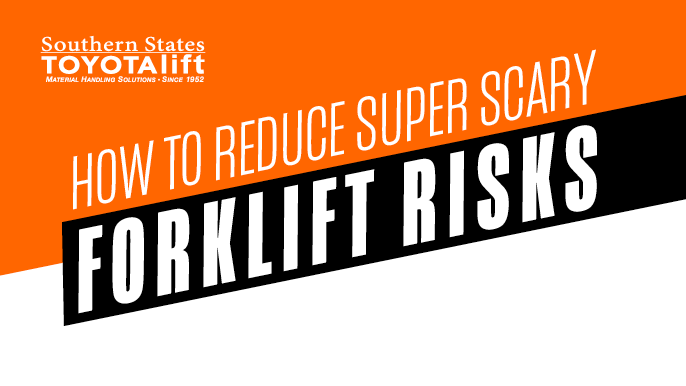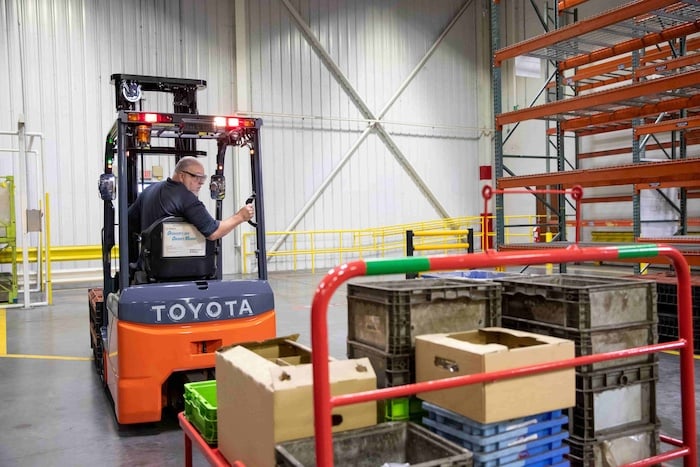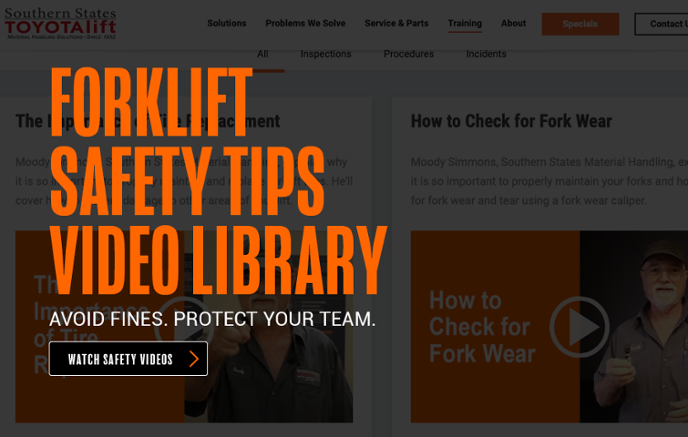How To Reduce Super Scary Forklift Risks
by James Averitt, on Oct 3, 2023 3:38:00 PM
 Want to hear something scary? One out of every 10 forklifts is involved in an accident each year. That means you are 6 times more likely to be injured by a forklift than in a car accident. Forklift accidents result in severe injuries for almost 35,000 workers annually. And that doesn’t count the roughly 87 people killed in forklift accidents yearly.
Want to hear something scary? One out of every 10 forklifts is involved in an accident each year. That means you are 6 times more likely to be injured by a forklift than in a car accident. Forklift accidents result in severe injuries for almost 35,000 workers annually. And that doesn’t count the roughly 87 people killed in forklift accidents yearly.
But what’s even more frightening is that most of those accidents were avoidable. OSHA estimates 70% of all forklift accidents are preventable with more stringent training policies. So, what can you do to keep your warehouse from becoming another statistic? Read on to learn how to reduce forklift accidents in your facility.
Forklift Rollovers
Rollovers are the number 1 cause of forklift fatalities in the US. They account for a quarter of all forklift accidents.
Many factors contribute to forklift rollovers. Yet, operators can prevent most of these by paying attention to 3 specific areas.
Quick Turning
Unlike modern cars, forklifts use the rear wheels to turn. This tightens their turning radius. But it also causes the back end to swing outward. On fast turns, this swing can cause the forklift to tip over. As a result, operators must make only slow, controlled turns to avoid tipping.
Speeding
Pilots talk about the 200-hour rule. It’s the amount of training someone needs before becoming comfortable enough to be really dangerous. This principle holds true for forklift operators too.
As an operator gains experience, they become more comfortable with the forklift. And they become more confident in their abilities. In forklift operators, this can lead to speeding.
Excessive speed contributes to most forklift accidents by shortening operator reaction time. But it is also a significant cause of forklift rollover. Therefore, avoid speed-related accidents by operating forklifts no faster than 8 miles per hour. And reduce your speed further to 3 mph when pedestrians are present.
Driving With Elevated Loads
Driving with elevated loads is a common yet risky occurrence. Elevated loads raise the forklift’s center of gravity. This makes turning, moving, and grade changes potentially hazardous.
To avoid a top-heavy forklift, OSHA recommends operators carry loads as low to the ground as possible. This should be about 4 inches from the floor.
Pedestrian Impacts
Out of all forklift-related deaths, 36% of victims are pedestrians. The average forklift weighs up to 9,000 lbs. This means forklifts cause severe damage to anything or anyone they hit. These kinds of accidents usually involve significant human error. And they can be tricky to avoid. However, two common factors contribute to these fatalities.
Poor Training
Forklift safety training isn't only for forklift operators. Anyone who spends time in your warehouse or might encounter a forklift during their duties needs training. Train all your staff on the protocols to keep operators and pedestrians safe.
Insufficient Signage
Warning signs and zone markings are a vital part of warehouse safety. Inadequate marking of forklift zones is a failure to alert pedestrians to danger. And this failure leads to forklift injuries.
Mark all forklift zones with floor tape and floor signs. Floor markings of this sort are highly visible, easy to install, and surprisingly durable. Be sure to mark aisles, walkways, ledges, traffic lanes, and other hazards.
Falling Loads
Forklift loads contribute to the thousands of workers injured by falling objects yearly. Yet, most of these injuries are avoidable with proper training.
Unsecured Loads
While many loads are secured to the pallet using shrink wrap or banding. Unsecured loads can fall off the pallet endangering pedestrians and damaging products. When operating with unsecured loads, slow down and avoid excessive braking or sudden turns.
Unbalanced Loads
Unbalanced loads decrease the stability of the forklift. This instability can cause the forklift to tilt, which increases the likelihood that product will slip from the pallet. Falling product is dangerous to the forklift driver, pedestrians, warehouse equipment, and surrounding material.
Avoid this potentially fatal fall by loading forklifts evenly. Balanced loads must also be adequately secured. And operators should angle forks upward during transport for extra safety.
Exceeded Load Capacities
Forklift design determines what weight it can lift and to what height. Exceeding these load maximums causes forklifts to fail and the load to come crashing down.
Load maximum information is printed on the data card fixed to each forklift. Operators must be comfortable reading forklift data cards to determine the truck's maximum load. And pallets should be labeled with their load weight.
Check out: How to Read a Forklift Data Plate
Falling Forklifts
Crossing between the loading dock and a trailer is one of the most dangerous moments for a forklift operator. Improperly secured trailers or faulty equipment can cause the forklift to fall from the loading dock. This kind of fall almost always results in serious injury for the operator.
Mechanical Failure
Forklifts are machines. And like any other machine, they need regular maintenance to perform. One critical area is brake maintenance. Forklifts, unlike cars, only have brakes on their front tires. This can make them slow to stop under the best of conditions. And failing brakes can lead to a forklift cruising right over the edge of an empty loading dock.
Routine inspections and regular service are required to prevent potentially dangerous equipment failures. So run daily inspections of your forklift fleet. And stay on top of maintenance by investing in a service plan.
Insufficient Engineering Controls
Training only goes so far. Some engineering controls, such as dock levers and trailer dock locks, are critical to ensuring a safe loading dock environment for your forklifts. Ensure your loading dock is using engineering controls to keep your warehouse safe.
Collisions
Forklift collisions are another common forklift accident in many warehouses. Depending on the speed and the material carried, they result in varying degrees of damage. But no collision is a good collision. Thankfully, the two most common causes are easy to avoid.
Warehouse Layout
Space is money in a warehouse. For that reason, many warehouses keep aisle space to a minimum. But, the average forklift is not designed to operate in a narrow aisle environment.
Take your warehouse layout into account when investing in forklifts for your fleet. Without enough space to operate, your forklifts will collide with racks. The damage could be catastrophic.
Check out: Warehouse Storage Solutions
Blocked Vision

Even when doing everything right, a load can block the forklift operator’s field of vision. Driving with an obstructed field of view is an accident waiting to happen. Obstacles and pedestrians are easily hidden by large loads, making the warehouse a minefield of collision hazards.
To avoid this, forklift operators should drive backward when carrying large loads. This ensures a clear field of view and dramatically reduces the risk of collision.
Check out: New Toyota High-Tech Forklift Safety Accessories
Avoid Scary Forklift Accidents
Forklifts are essential tools in any productive warehouse. Yet, poor operating practices make them the deadliest equipment in your building. Protect your workforce and your business by implementing forklift best practices today.
Check out our forklift safety video library to learn more about avoiding forklift accidents. Or contact our Solutions Team online or visit one of our locations throughout Florida and Georgia.
Florida
Jacksonville
Lakeland
Ocala
Orlando
Tampa
Winter Haven
Georgia
Albany
Macon
Columbus
Valdosta
Further Reading
5 Simple Steps to Improve Warehouse Safety
Top 8 Forklift Safety Products
Mobile Forklift Repair: Get Your Forklift Fixed Fast









